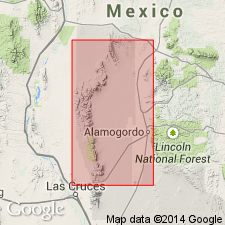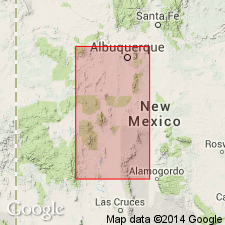
- Usage in publication:
-
- Manzano series
- Modifications:
-
- First used
- Dominant lithology:
-
- Quartzite
- Sandstone
- Limestone
- Shale
- Salt
- Gypsum
- AAPG geologic province:
-
- Many basins
Summary:
First use of name [together with 2 other reports by Herrick and Bendrat in The American Geologist, v. 25, and by Herrick in University of New Mexico Bulletin, v. 2, pt. 3--all have similar information, which is combined and summarized here]. Intent to name not stated; no type locality designated [probably named for Manzano Mountains, Torrance Co, NM]. Is a large series of coarse red quartzites and sandstones interbedded with dark, earthy limestones and shales; few fossils except petrified wood. Overlies [unnamed] massive gray siliceous lime [this lime may be part of Manzano--not clearly stated] which in turn overlies Coyote sandstone (new, a formation which marks the transition to Permo-Carboniferous). [Overlying and underlying units not clearly stated, and lithologic description--which follows--is very unclear]. Composed of coarse red quartzite and sandstone interbedded with dark earthy limestone and shale. Is overlain by group of red quartzites, sandstones, shales, and marls recognized as the equivalent of the "red series" of TX and KS. Manzano is present in Sandia Range and foothills of Jemez Mountains, Sandoval and Bernalillo Cos (San Juan and Estancia basins); Manzano Mountains, Bernalillo and Torrance Cos (Estancia basin); San Andreas Mountains, Socorro Co (Orogrande basin); and Sacramento Mountains foothills, Otero Co (Orogrande basin).
Source: GNU records (USGS DDS-6; Denver GNULEX).

- Usage in publication:
-
- Manzano group*
- Modifications:
-
- Revised
- Age modified
- AAPG geologic province:
-
- San Juan basin
- Estancia basin
- Orogrande basin
Summary:
Manzano group revised in that 1) it is underlain unconformably by the newly named Magdalena group, and 2) that the upper contact is revised upward 300-500 ft to include a thick limestone with an abundant fauna (limestone not present in the Sandia Mountains or west of the Rio Grande). The Pennsylvanian series in report area--the Rio Grande Valley of NM, Dona Ana, Sierra, and Socorro Cos (Orogrande basin), Bernalillo Co (Estancia basin), and Valencia Co (San Juan basin)--is split into two divisions: Magdalena group (at base, newly named in this report), and Manzano group (here revised). Magdalena is divided into (ascending) Sandia beds [formation] and Madera limestone (both revised) in northern part of extent--Socorro, Valencia, and Bernalillo Cos (Orogrande, San Juan, and Estancia basins); Magdalena group is not subdivided to south in Sierra Co (Orogrande basin). Manzano is not present on west side of Rio Grande. Fossils from the Manzano were collected by Lee and studied by Girty. These fossils were found to be Upper Carboniferous, and correspond in their relations to upper part of Hueco formation in TX and Aubrey [formation] in the Grand Canyon region. Therefore, the Permian-Jurassic age assigned by Herrick (1900) is here modified to Pennsylvanian.
Source: GNU records (USGS DDS-6; Denver GNULEX).
For more information, please contact Nancy Stamm, Geologic Names Committee Secretary.
Asterisk (*) indicates published by U.S. Geological Survey authors.
"No current usage" (†) implies that a name has been abandoned or has fallen into disuse. Former usage and, if known, replacement name given in parentheses ( ).
Slash (/) indicates name conflicts with nomenclatural guidelines (CSN, 1933; ACSN, 1961, 1970; NACSN, 1983, 2005, 2021). May be explained within brackets ([ ]).

